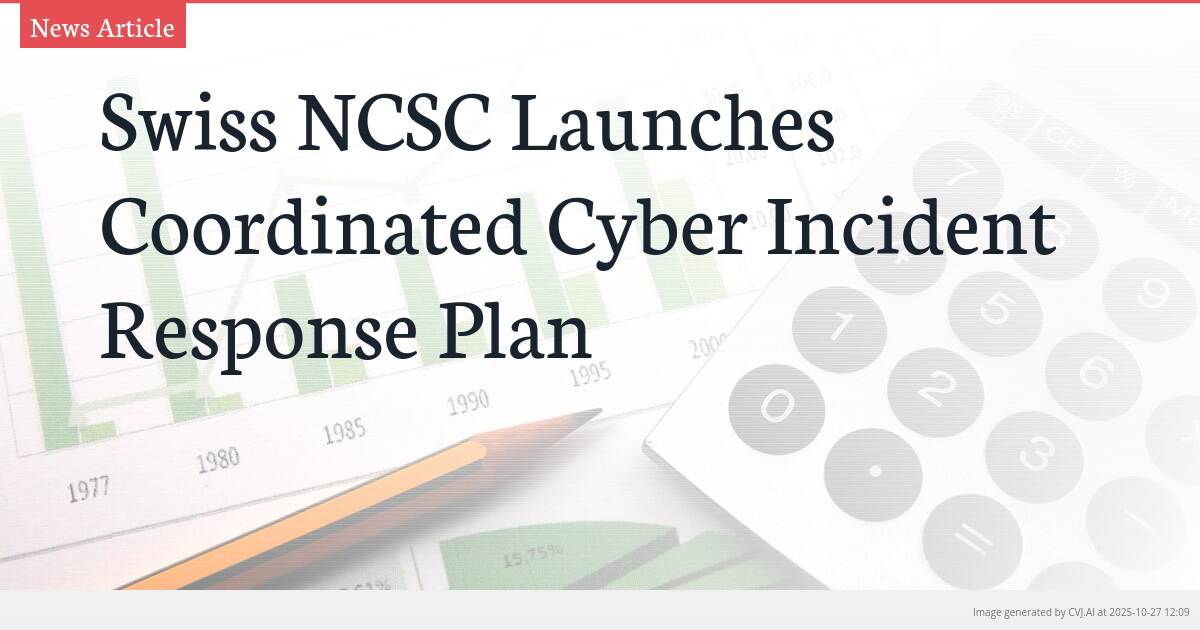This summary text is fully AI-generated and may therefore contain errors or be incomplete.
Introduction
The National Cyber Security Centre (NCSC) has developed a comprehensive framework for managing cyber incidents across Switzerland, recognizing that interconnected digital systems mean attacks can simultaneously impact multiple organizations. This coordinated approach brings together federal, cantonal, and business stakeholders to ensure rapid, unified responses to cybersecurity emergencies that threaten economic stability and national security.
Key Points
- Addresses the challenge of interconnected digital systems where incidents can rapidly spread across multiple organizations
- Involves coordinated participation from business sectors, cantonal governments, and federal authorities
- Establishes structured federal government organization protocols for effective incident management
The Challenge of Interconnected Digital Systems
The foundation of Switzerland’s new cyber incident response strategy lies in addressing the fundamental reality of modern digital infrastructure: the close interconnection of systems across organizational boundaries. As the NCSC’s analysis indicates, this interconnectedness means that cyber incidents no longer remain contained within single entities but can have immediate, cascading effects across multiple organizations simultaneously. This creates a complex threat landscape where a breach in one system can rapidly propagate through digital networks, affecting businesses, government agencies, and critical infrastructure across the country.
This systemic vulnerability represents a significant challenge for traditional incident response approaches, which typically focus on individual organizational boundaries. The NCSC’s framework acknowledges that effective cybersecurity in today’s environment requires moving beyond siloed defense strategies to address the collective nature of digital threats. The interconnected nature of Switzerland’s digital economy means that cyber incidents affecting one sector can quickly spill over into others, potentially disrupting financial services, healthcare, energy, and transportation systems that form the backbone of the nation’s economic stability.
Stakeholder Coordination Framework
At the heart of the NCSC’s strategy is the recognition that successfully managing cyber incidents requires coordinated participation from all affected stakeholders. The plan specifically identifies three critical groups: the business and economic community, the cantons, and the federal government. Each brings essential capabilities and perspectives to the table, creating a multi-layered defense and response system that leverages Switzerland’s unique federal structure while addressing the borderless nature of cyber threats.
The business and economic community’s involvement is particularly crucial, as private sector organizations operate much of Switzerland’s critical digital infrastructure and hold sensitive economic data. Their participation ensures that incident response protocols align with operational realities and business continuity requirements. Meanwhile, the cantons bring localized knowledge and enforcement capabilities, while the federal government provides national coordination, intelligence sharing, and technical expertise through the NCSC. This tripartite approach creates a comprehensive ecosystem for cyber incident management that spans jurisdictional and organizational boundaries.
Federal Government Organization and Protocol
The NCSC’s plan establishes clear protocols for how the federal government organizes itself to ensure effective, coordinated management of cyber incidents. This structured approach addresses the need for rapid decision-making and resource allocation during cybersecurity emergencies, when minutes can mean the difference between contained incidents and widespread disruption. The framework outlines roles, responsibilities, and communication channels that enable swift mobilization of federal capabilities while maintaining coordination with cantonal and private sector partners.
By defining federal government organization protocols in advance, the NCSC aims to eliminate confusion and delays that can hamper incident response efforts. The plan establishes standardized procedures for information sharing, resource deployment, and decision escalation that ensure all stakeholders operate from a common playbook during crises. This organizational clarity is particularly important given Switzerland’s federal system, where responsibilities are distributed across multiple levels of government, and coordination between federal and cantonal authorities is essential for effective nationwide response.
Economic Implications and Business Community Integration
The integration of the business and economic community into the NCSC’s coordinated response framework reflects growing recognition of cybersecurity’s critical role in maintaining economic stability. Cyber incidents can disrupt supply chains, compromise sensitive business information, undermine consumer confidence, and create significant financial losses. By involving business stakeholders directly in incident response planning, Switzerland aims to minimize economic disruption and protect the country’s reputation as a secure hub for international business and finance.
This approach acknowledges that private sector organizations often possess advanced cybersecurity capabilities and threat intelligence that can complement government resources. The coordinated framework facilitates two-way information sharing, enabling businesses to benefit from government threat intelligence while providing authorities with early warning of emerging threats detected in commercial networks. This collaborative model represents a significant evolution in public-private partnership for cybersecurity, moving beyond advisory roles to operational integration during incident response.
📎 Read the original article on admin.ch

